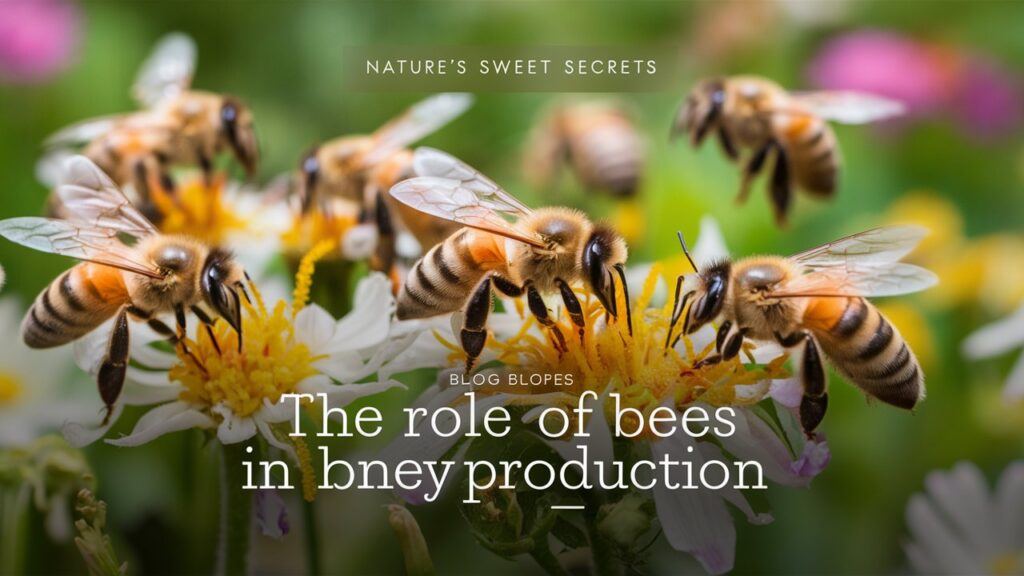Bees are extraordinary creatures that play an essential role in the natural world, especially in the production of honey. Their impact goes beyond the golden liquid we spread on toast or add to tea; bees are critical to agriculture, ecosystems, and economies worldwide. The Western honey bee (Apis mellifera), in particular, is central to commercial honey production. Through a fascinating series of processes—ranging from nectar collection to enzymatic transformation—bees create honey while simultaneously supporting biodiversity and crop pollination.
The Honey-Making Process
Bees work together in an organized system to produce honey. Each stage of the process involves specialized tasks performed by different members of the hive.
Step 1: Nectar Collection
How Bees Gather Nectar
Foraging bees begin the process by seeking out flowers rich in nectar. They use their long, tube-like tongues to extract this sweet liquid, which is stored in their specialized honey stomachs.
- A single bee can visit hundreds of flowers in a day.
- A colony of 50,000 bees travels over 2.5 million miles to produce just 50 pounds of honey.
Importance of Flower Diversity
Bees collect nectar from various plants, which impacts the flavor and color of the honey. This is particularly relevant for varieties like unique wildflower honey, which derive their unique qualities from a mixture of blossoms.
Step 2: Nectar Processing Inside the Hive
Role of House Bees
When foraging bees return to the hive, they transfer the nectar to house bees. These bees begin the drying process by repeatedly spreading the nectar on their tongues to expose it to air.
Enzymatic Transformation
The real magic occurs when bees add enzymes from their saliva to the nectar. These enzymes break down complex sugars into simpler ones, such as glucose and fructose. This chemical transformation gives honey its sweetness and long shelf life.
Step 3: Curing and Storage
Wax Cells and Airflow
Once processed, the nectar is stored in hexagonal wax cells. Bees fan their wings to evaporate moisture, further thickening the nectar into honey.
Sealing the Honeycomb
After curing, the honey is sealed with a wax cap to protect it. This ensures the honey remains fresh and available for the colony’s future use.
Beyond Honey, Bees’ Role in Agriculture
While honey production is remarkable, bees’ contributions to agriculture are even more profound. Their pollination services are vital to global food production and biodiversity.
-
Pollination Services
Supporting Global Food Crops
Bees are responsible for pollinating roughly one-third of the world’s crops. Fruits, vegetables, nuts, and oilseeds like almonds and sunflowers depend heavily on bees for reproduction.
Enhancing Crop Quality
Pollination by bees doesn’t just increase yield; it also improves the quality of crops. For example:
- Fruits like apples and cherries become larger and juicier.
- Vegetables such as cucumbers develop more uniform shapes.
-
Economic Impact of Bee Pollination
Financial Contributions to Agriculture
In the United States alone, honey bee pollination adds an estimated $20 billion to crop production annually. This highlights the economic importance of these small yet mighty workers.
Dependency of Specific Crops
Certain crops, such as blueberries and almonds, rely almost entirely on honey bee pollination. Without bees, these industries would face severe challenges.
The Honey Industry
The production of honey is not only a natural wonder but also a thriving global industry that supports millions of livelihoods.
-
Honey Varieties and Their Appeal
Spotlight on Wildflower Honey
Wildflower is a unique type of honey made from the nectar of multiple wildflowers. Its characteristics are influenced by the types of flowers blooming in a specific region and season.
- Flavor Profile: Rich and complex, with a variety of floral undertones.
- Color and Texture: Can range from light amber to dark brown, depending on the wildflowers.
- Health Benefits: Known for its antioxidants and potential allergy-relief properties, as it contains traces of local pollen.
The Role of Biodiversity in Honey Quality
The availability of diverse wildflowers ensures the unique taste and nutritional benefits of honey wildflowers, making it a favorite among honey enthusiasts.
-
The Economics of Honey Production
Leading Honey Producers
Countries like China, Turkey, and the United States dominate global honey production. Beekeepers in these regions work to ensure sustainable practices while meeting high demand.
Export and Trade
Honey is a valuable export commodity. For example, Australia exports about 10% of its honey to regions such as North America, Asia, and the Middle East, demonstrating the global love for this natural sweetener.
Challenges Facing Bees
Despite their critical roles, bees face numerous threats that endanger their populations and the ecosystems they support.
-
Declining Bee Populations
Causes of the Decline
Factors such as habitat loss, pesticide use, and climate change are leading to alarming declines in bee numbers. Diseases like colony collapse disorder (CCD) further exacerbate the problem.
Implications for Honey and Agriculture
A decline in bee populations affects honey production and jeopardizes the pollination of essential crops, threatening food security worldwide.
-
Conservation Efforts to Protect Bees
Sustainable Farming Practices
Farmers are adopting bee-friendly practices, such as reducing pesticide use and planting pollinator-friendly crops.
Creating Bee Habitats
Efforts to preserve natural habitats and establish wildflower-rich areas are vital for supporting bee populations and enhancing the production of varieties like wildflower honey.
Conclusion
Bees are indispensable to the production of honey and the sustenance of our agricultural systems. From the intricate process of nectar collection to creating delicious honey varieties like wildflower honey, these industrious insects embody efficiency and harmony with nature. Beyond honey, their pollination services are essential for global food security and economic stability. Protecting bees ensures the continued enjoyment of honey and the health of ecosystems and agricultural systems worldwide.



